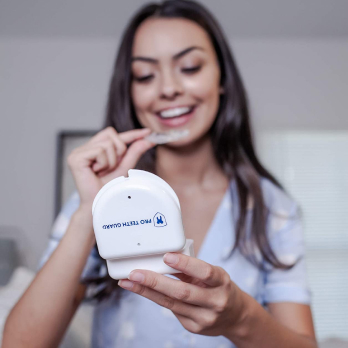Can I Wear My Night Guard After Teeth Whitening?
4th Oct 2025
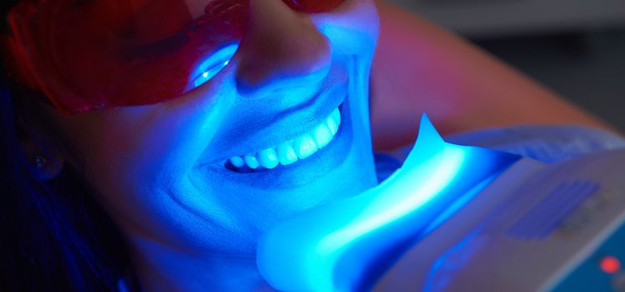
Whitening your teeth can make them look great, but it can also leave them feeling a bit sensitive. If you wear a night guard, you might wonder if it’s okay to use it after whitening.
The short answer: yes, but it’s best to wait a little. In this guide, we’ll explain when it’s safe to wear your night guard again and how to protect your teeth without affecting your whitening results.
Why You Might Hesitate to Wear a Night Guard After Whitening
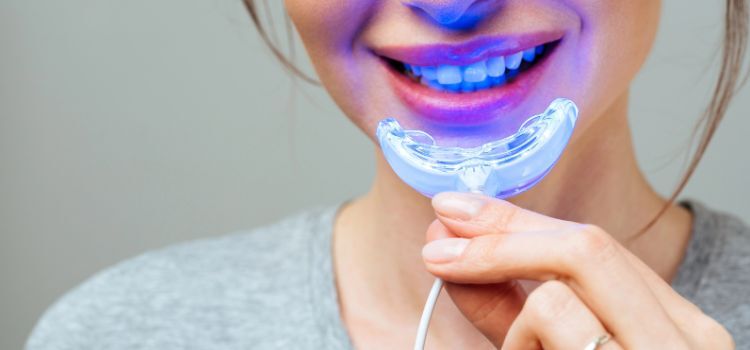
After whitening your teeth, you may notice a bit of extra sensitivity. That’s because whitening products can temporarily weaken the enamel, making your teeth more sensitive to pressure, temperature, and even your night guard.
You might also worry about a few things, like:
- Will the night guard trap leftover whitening gel?
- Could it undo the whitening results?
- Might it cause more discomfort while my teeth are still sensitive?
Is It Safe to Wear a Night Guard After Teeth Whitening?
Yes, it’s generally safe to wear your night guard after teeth whitening—but timing is important.
According to Colgate, right after whitening, your teeth are more porous and sensitive. Wearing your night guard too soon could trap leftover whitening gel against your enamel or make the sensitivity worse.
To play it safe, wait 24 to 48 hours after whitening before putting your night guard back in. This gives your teeth time to settle and helps prevent discomfort.
Note: If your teeth feel extra sensitive, it’s okay to wait a little longer or check in with your dentist for advice.
Related Articles:
- Best Toothpaste For Sensitive Teeth
- Teeth Feel Weird? 5 Common Issues
- Why Do My Teeth Hurt When I Wake Up?
How Long Should You Wait Before Wearing a Night Guard?
It’s not a proven fact in the literature that you must wait exactly 24‑48 hours before using a night guard, but the science suggests that’s a safe and reasonable recommendation..
This gives your enamel time to recover and helps reduce sensitivity.
However, the exact wait time can depend on a few things:
Type of whitening used (in-office treatments are often stronger than at-home kits)
Your sensitivity level
Whether any whitening gel is still present on your teeth
Note: Since several studies show that sensitivity is highest immediately after whitening and tends to resolve or lessen significantly within 24 hours, waiting 24‑48 hours before using something that might put pressure or additional contact on the teeth (like a night guard) is consistent with the research.
Night Guard vs Whitening Trays: What’s the Difference?
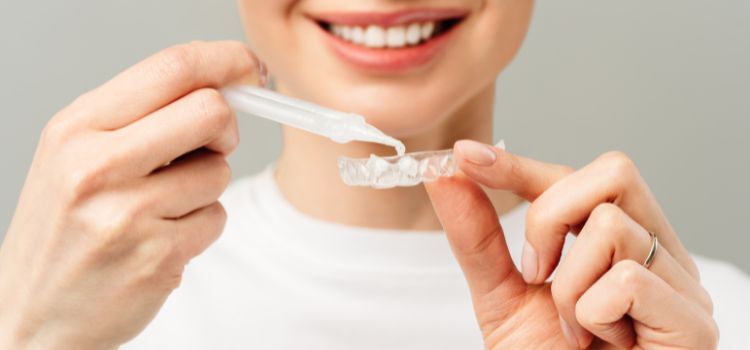
Night guards and whitening trays might look alike, but they serve very different purposes—and using one in place of the other can lead to problems.
A night guard is designed to protect your teeth from grinding or clenching while you sleep. It’s made from thicker, more durable material to handle pressure and prevent wear on your teeth.
On the other hand, a whitening tray is designed to hold whitening gel in place on your teeth. It’s usually softer and more flexible, allowing the gel to spread evenly across the enamel.
If you're thinking about using your night guard as a whitening tray, it’s best not to. Night guards aren't made to hold gel and can trap it in the wrong places, causing gum irritation or uneven whitening. And whitening trays won’t protect your teeth from grinding—they’re simply not strong enough.
Pro Tip: For best results, use your night guard and whitening tray separately, and follow your dentist’s recommendations for timing.
Related Articles:
- Can I Use My Whitening Trays As A Night Guard?
- Dental Tourism for a Night Guard
- Night Guard Turning Yellow
What If You Already Wore Your Night Guard Too Soon?
Don’t worry—if you wore your night guard right after whitening, you're not alone. Just follow these simple steps to protect your teeth and stay comfortable:
Step 1: Rinse thoroughly
Remove your night guard and rinse both your mouth and the guard with water to get rid of any leftover whitening gel.
Step 2: Take a break
Wait at least 24 to 48 hours before wearing your night guard again. This gives your teeth time to recover and reduces the risk of irritation.
Step 3: Use toothpaste for sensitivity
Brush with a toothpaste designed for sensitive teeth to help soothe any discomfort.
Step 4: Monitor how your teeth feel
If you notice lasting pain or sensitivity that doesn’t go away after a couple of days, it’s best to talk to your dentist.
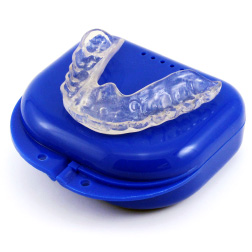
- Most Popular
- Hard Outside, Soft Inside
- 2MM Thick
- Moderate / Heavy
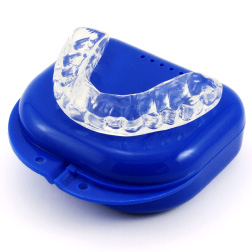
- Most Durable
- Hard Materials
- 1.5MM Thick
- Heavy / Severe
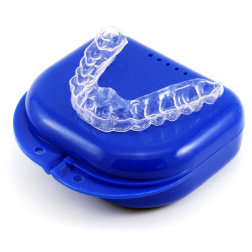
- For Day Time Use
- Thin, Barely Visible
- 1MM Thick
- Light / Moderate
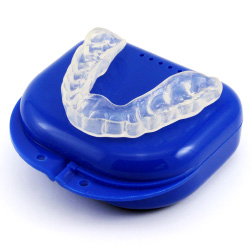
- For Clenching
- Flexible & Soft
- 1.5MM Thick
- Light / Moderate
Tips for Protecting Your Teeth After Whitening
After whitening, your teeth can be more sensitive and prone to staining. Here are a few simple tips to keep your smile bright and your teeth healthy:
Avoid staining foods and drinks
Stay away from coffee, tea, red wine, berries, and dark sauces for at least 24–48 hours after whitening. These can easily stain freshly whitened teeth.
Drink plenty of water
Water helps rinse away food particles and reduce the risk of stains. It also keeps your mouth hydrated, which is helpful if you're dealing with sensitivity.
Brush gently
Use a soft-bristled toothbrush and brush with a toothpaste for sensitive teeth. Avoid harsh scrubbing, which can irritate your enamel.
Clean your night guard regularly
Once it’s safe to wear your night guard again, make sure it's clean before each use. Rinse it with water or use a night guard cleaner to remove any bacteria or buildup.
Wait before using your night guard
As mentioned earlier, give your teeth time to recover. Waiting at least 24–48 hours after whitening helps prevent irritation and protects your results.
Note: Following these simple steps can make a big difference in keeping your teeth feeling good and looking their best.
When to Talk to Your Dentist
Most people can safely return to wearing their night guard after a short break—but in some cases, it’s a good idea to check in with your dentist. Here’s when to reach out:
If sensitivity lasts more than a few days
Lingering pain or discomfort could mean your teeth need more time to recover—or that something else is going on.
If your night guard feels tight or uncomfortable
Teeth can shift slightly after whitening. If your guard no longer fits properly, your dentist can check the fit or recommend adjustments.
If you’re unsure when to start wearing it again
When in doubt, your dentist can give you personalized guidance based on your whitening treatment and oral health.
Note: Your dentist is your best resource when it comes to keeping your teeth healthy, comfortable, and protected—especially when you’re using both a night guard and whitening products.
Final Thoughts: Night Guard and Teeth Whitening – What You Should Know
Wearing your night guard after teeth whitening is safe—just wait 24 to 48 hours to let your teeth recover and reduce sensitivity. Night guards and whitening trays aren’t the same, so don’t use one in place of the other.
If you wore your night guard too soon, no worries. Rinse it, take a break, and check with your dentist if needed.
Need a high-quality, custom-fit night guard? Pro Teeth Guard offers dentist-made night guards at an affordable price—built for comfort and long-term protection. Keep your smile safe and bright.
References:
- Colgate. (n.d.). How to get rid of teeth sensitivity after whitening. Colgate. Retrieved July 26, 2025, from https://www.colgate.com/en-ph/oral-health/teeth-whitening/how-to-get-rid-of-teeth-sensitivity-after-whitening
- Smile Dental Center. (n.d.). Aftercare tips for professional teeth whitening. Smile Dental Center. Retrieved July 26, 2025, from https://www.smiledentalcenterct.com/blog/cosmetic-dentistry/aftercare-whitening/
- Butera, A., Tortonesi, G. M. N., Viganò, E., Bertani, F., Lago, G., Francetti, L., Maspero, C., & Esposito, F. (2024). Evaluation of the effectiveness of different types of dental bleaching: In-office, at-home, and combined bleaching with hydrogen or carbamide peroxide. Bioengineering, 11(12), Article 1178. https://doi.org/10.3390/bioengineering11121178
- Feliz-Matos, L. E., & Yunes Fragoso, P. M. (2023). Dental sensitivity in tooth whitening and its relationship to peroxides concentrations: A cross-sectional retrospective study. Frontiers of Oral and Maxillofacial Medicine, 5(3), Article 3. https://doi.org/10.21037/fomm-21-121
- Carey, C. M. (2014). Tooth whitening: What we now know. Journal of Evidence-Based Dental Practice, 14 Suppl, 70–76. https://www.ncbi.nlm.nih.gov/pmc/articles/PMC4058574/

- Most Popular
- Hard Outside, Soft Inside
- 2MM Thick
- Moderate / Heavy

- Most Durable
- Hard Materials
- 1.5MM Thick
- Heavy / Severe

- For Day Time Use
- Thin, Barely Visible
- 1MM Thick
- Light / Moderate

- For Clenching
- Flexible & Soft
- 1.5MM Thick
- Light / Moderate
